|
Thank you for staying connected with EnviroConnections by Maricopa County Environmental Services Department.
This newsletter will be available quarterly and on special occasions. Get all the issues! If you are not yet subscribed, you can sign up now and  this with a friend. this with a friend.

For the past several years, Maricopa County Environmental Services (MCESD) has been conducting an aggressive year-round mosquito surveillance and abatement program.
Our mosquito season typically runs from April through the end of October, with peak mosquito activity occurring in August through September. Some years, mosquito problems in Maricopa County have started as early as March or have extended until the end of November.
MCESD’s Vector Control Division’s surveillance and abatement operations include monitoring and treating thousands of sites. More than 750 routine mosquito traps are set weekly at sites that we have identified as areas that regularly represent challenges or problems in terms of mosquito breeding. In addition to routine traps, we set complaint-driven traps; these are in response to a citizen’s complaint of mosquito issues.
In our renovated and expanded Vector Control Lab, the Laboratory Technicians sort and test the mosquito samples collected. Female Culex mosquitoes are tested for West Nile virus and Saint Louis encephalitis virus.
Vector Control’s Lab also conducts tests for the Chikungunya virus by sampling female Aedes aegypti mosquitoes caught within Maricopa County.

We have recently received some guidelines/protocols from CDC for conducting Zika and Dengue tests. Vector Control is now working on preparing the lab for these tests and should start as early as end of March or the beginning of April. The results of these tests on Aedes aegypti mosquitoes would initially be sent over to CDC for validation of our laboratory procedures. The tests would be similar to the ones that Vector Control has been conducting for Chikungunya, using a supply of Aedes aegypti female mosquitoes collected through our surveillance trapping.
In the meantime, there has not been any indication of the Zika virus being present in Maricopa County at this time. Along with MCESD’s efforts, Maricopa County Public Health has been working with the healthcare community to identify any potential human cases, particularly among travelers to Zika hot spots.
Concerned residents can learn more by visiting our newly created Zika Web page as part of the FightTheBiteMaricopa.org Web site.
|
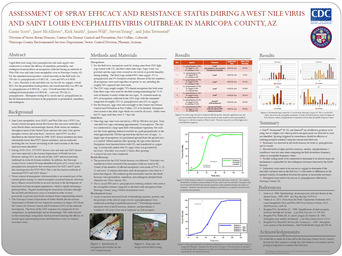
MCESD's Vector Control Division's work has been recognized by the Centers for Disease Control and Prevention (CDC). A poster that was done by Vector Control and the CDC for the American Mosquito Control Association (AMCA) 82nd Annual Meeting in Savannah, Georgia, has served as a very illustrative educational tool by CDC.
It is a study on insecticide resistance our team did last summer.
This poster was also used for a mosquito conference in California.
Click on enclosed image to Enlarge/View
Back to Top
|
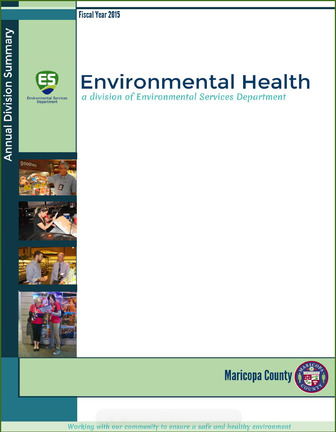
The MCESD Environmental Health Division’s Annual Report for Fiscal Year 2015 is now available for your review on the department’s Web site. This report provides a high level summary of the many accomplishments that our staff and the division were able to achieve during this time period, thanks to the collaboration and engagement of County leaders, the community and the food industry.
The format and style of the report is meant to provide an interesting and concise way to share our efforts and accomplishments. We invite you to visit our Web site or click on EH Annual Report – FY 2015 to review this report of which you are an intrinsic part.
Back to Top
Submitted by: Vas Hofer, EH Permitting Services Managing Supervisor
Are you considering purchasing a business and would like to know what items need to be addressed in order to qualify for a permit? If so, then maybe a Plan Review Inspection Upon Request is an option you may want to consider. This inspection is conducted by a Plan Review Inspector and will provide you with a detailed list of items that will need to be addressed prior to qualifying for an operational permit with the Department.

Things to Know:
1. The establishment must meet all current code requirements.
2. Prior inspections at an existing facility will not provide a comprehensive list of construction-related requirements needed to qualify for a new permit.
3. The fee for an Inspection Upon Request is $240/permit.
4. A form (Inspection Upon Request) will need to be submitted the Department.
Back to Top
|

Submitted by: Vas Hofer, EH Permitting Services Managing Supervisor
Were you aware that the Maricopa County Board of Supervisors approved changes to the Environmental Health Code last year to allow new owners of existing food establishments to remain in business for up to 30 days while their permit application review is in progress? This change allows those that qualify to have continuity in operating their business and have 30 days to correct violations that are not deemed to be imminent health hazards.
Things to Know:
1. The prior owner must hold a valid permit at the time of the ownership change.
2. The new owner must submit a 30 Day Transition Application to the Department prior to the change of ownership.
3. The New Owner must first receive written approval from the Department prior to operating.
4. If applying for multiple permits, separate applications are required for each permit.
5. The new owner must not conduct any operation that requires a variance without prior approval.
6. The new owner must be in good standing with the Department (i.e. no outstanding legal actions or unpaid balances).
7. The new owner must agree to immediately cease operations if any of the following occur:
a. An imminent health hazard such as fire, flood, electrical or water outage, sewage backup, misuse of poisonous or toxic materials, onset of an apparent foodborne illness outbreak, gross insanitary occurrence or condition, or other circumstance that may endanger public health.
b. Evidence of live insect and/or vermin activity.
c. Missing or inoperable plumbing fixtures essential to facility operations, such as hand sinks and warewashing equipment.
d. Inadequate supply of hot and cold water.
e. Insufficient, inadequate, or unapproved food temperature control equipment.
8. The new owner shall abide by the responsibilities of a permit holder as referenced in the U.S. Food and Drug Administration 2013 Food Code § 8-304.11.
Please contact the Plan Review Program with any questions at (602)506-6980.
Back to Top
|

Submitted by: David Morales, Quality & Compliance Managing Supervisor
The 2013 FDA Food Code requires that all food establishments have a procedure for responding to vomiting and diarrheal events. This requirement is specified under Regulation 2-501.11 and states:
A FOOD ESTABLISHMENT shall have procedures for EMPLOYEES to follow when responding to vomiting or diarrheal events that involve the discharge of vomit or fecal matter onto surfaces in the FOOD ESTABLISHMENT. The procedures shall address the specific actions EMPLOYEES must take to minimize the spread of contamination and the exposure of EMPLOYEES, consumers, FOOD, and surfaces to vomitus or fecal matter. Pf
The Food Code specifies that the Person in Charge is to exclude (send home) or restrict (not allow employee to work with food or food contact surfaces) a food employee who exhibits, or reports a symptom, or who reports a diagnosed illness or a history of exposure to Norovirus. A clean-up and response plan is intended to address situations where a food employee or customer becomes physically ill in areas where food may be prepared, stored or served. Once an accident has occurred, timely and effective clean-up is vital.
When developing a plan that addresses the need for the cleaning and disinfection of a vomit and/or diarrheal accident, a food establishment must consider:
• the procedures for containment and removal of any accident, including airborne particulates;
• the procedure for cleaning and sanitizing any surfaces that may have become contaminated;
• the procedures for discarding any food that may have been exposed to contamination;
• the availability of effective cleaning and sanitizing supplies and personal protective equipment (if needed).
• procedures for the disposal of and/or cleaning and disinfection of tools and equipment used to clean up the accident;
• train staff on how and when to use personal protective equipment and procedures to follow in containing, cleaning, and disinfecting a contaminated area;
• the closing off of areas that may have been contaminated until cleaned and sanitized,
• remove ill employee or customers form the establishment to prevent further illness from occurring.
Note: Effective cleaning of vomitus and fecal matter in a food establishment should be handled differently from routine cleaning procedures, please follow labeling instructions.
|
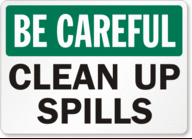
Sample Clean-Up Procedure for Vomit/Fecal Accidents:
1. Segregate the area.
2. Wear disposable gloves during cleaning. To help prevent the spread of disease, it is recommended that a disposable mask and/or cover gown (or apron) be worn when cleaning liquid matter.
3. Wipe up the matter with towels and dispose into a plastic garbage bag.
4. Mix a chlorine bleach solution that is stronger than the chlorine solution used for general cleaning [the Centers for Disease Control and Prevention recommends 1000-5000 ppm or 5-25 tablespoons of household bleach (5.25%) per gallon of water]. Note: quaternary ammonia is not an effective sanitizer for Norovirus.
5. If you using an EPA approved cleaning product the 2013 FDA Food Code requires follow-up with a chlorine, quaternary ammonia, or iodine as a final sanitizer step before putting equipment into use.
6. Apply the bleach solution and allow it to remain wet in the affected area for at least 10 minutes.
Allow to air dry. Dispose of any remaining sanitizer solution once the accident has been cleaned up.
7. Discard gloves, mask, and cover gown (or apron) in a plastic bag.
8. Take measures to dispose of and/or clean and disinfect the tools and equipment used to clean up vomit and fecal matter.
9. Properly wash hands.
10. Discard any food that may have been exposed.
11. Minimize the risk of disease transmission through the prompt removal of ill employees, customers and others from areas of food preparation, service, and storage.
Additional references:
FDA 2013 Food Code 2-501.11
Center for Disease Control: Preventing Norovirus Infection
Back to Top
|
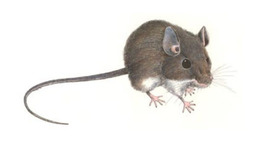
Submitted by John Townsend, Vector Control Division Manager
Hantavirus Pulmonary Syndrome (HPS) cases can occur throughout the southwest, including Maricopa County. There have been 11 cases in Maricopa County since the Sin Nombre virus* was first discovered in the Four Corners Region in 1993. Of the 11 Maricopa County cases, four have been fatal (36%).
The virus is shed in the feces, urine, and saliva of several rodent species that are native to the southwest. The deer mouse—which is located throughout the state—is the primary reservoir for the virus.
All of the HPS cases in Maricopa County have occurred during El Niño* events. Typically El Niño events increase winter and spring rainfall in Maricopa County. This rainfall increases the number of annual plants, seeds, and insects available as a food supply to the local deer mouse population; this increased food
supply results in a rapid increase in their population. This rapid upsurge in population increases the
probability of human contact, especially in outlying areas of Maricopa County where deer mice populations are greater. During these population explosions, the mice may be seeking food or shelter in garages or out buildings/sheds around the property.
If you find rodents nesting in areas around your property, extreme care should be taken when cleaning up the area. Never sweep, vacuum, or use a leaf blower to clean the area. This could result in the shed virus becoming airborne and entering your lungs. Contact a professional cleaning service if you are uncomfortable with cleaning the area in question.
|

However, if conducting the clean-up yourself, use the following wet clean up procedures to clean the area:
- Wear rubber gloves, long-sleeved clothing, and a dust mask when cleaning up the area.
- Use 1.5 cups of household chlorine bleach to a gallon of water as a disinfectant. You may also use Lysol or other cleaners that say disinfectant on the label and have phenol on the list of ingredients.
- Apply the disinfectant to the mouse droppings (feces) and urine and all areas where rodents have been at least 30 minutes before cleanup to give the disinfectant an opportunity to work. Use wet mopping or wet cleaning methods to carefully remove rodent droppings (feces) and urine from occupied buildings.
- Wet cleaning methods include keeping the area being cleaned wet at all times with the disinfectant being used to eliminate airborne particles. Once the area is wet it can then be cleaned by using a mop, sponge or paper towels, depending on the size of the area being cleaned.
-
If dead rodents or nesting material is found, wet the dead rodents and rodent nests with disinfectant, allowing at least 30 minutes for
disinfectant to work before removing.
- Dispose of rodent bodies or nesting material by placing a bag over your hand, picking up the rodent or nesting material, then reversing the bag back over the rodent and sealing.
-
If droppings, rodents, or nesting material have been treated properly with a sanitizer, they can be
double bagged and disposed in the regular trash bin.
-
Wash gloved hands in a general household
disinfectant and then in soap and water.
- Wash bare hands after removing gloves.
*Sin Nombre virus means “no name virus” in Spanish. It is the prototypical etiologic agent of the hantavirus cardiopulmonary syndrome
https://www.ncbi.nlm.nih.gov/pmc/articles/PMC3322788/
*El Niño refers to the large-scale ocean-atmosphere climate interaction linked to a periodic warming in sea surface temperatures across the central and east-central Equatorial Pacific
http://oceanservice.noaa.gov/facts/ninonina.html
Back to Top
|
Maricopa County goes entirely tobacco-free on March 16, 2016. Using any tobacco products (including smokeless tobacco) and e-cigarettes will be prohibited on all Maricopa County-owned properties.
Meet some of our employees who have successfully kicked the habit!
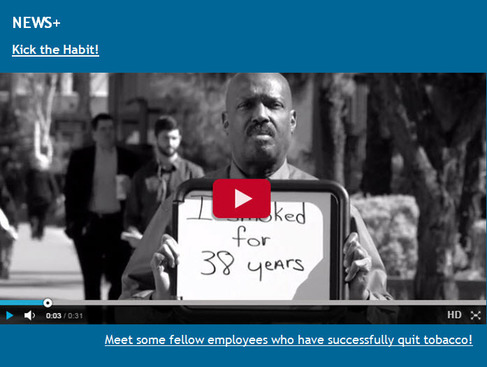

Follow Us, Like Us, Watch Us and More!
Maricopa County Environmental Services department is constantly working to make effective use of social media. You can subscribe to our YouTube channel, connect with us on Facebook and Twitter, and now also on Pinterest!
Back to Top
|
|